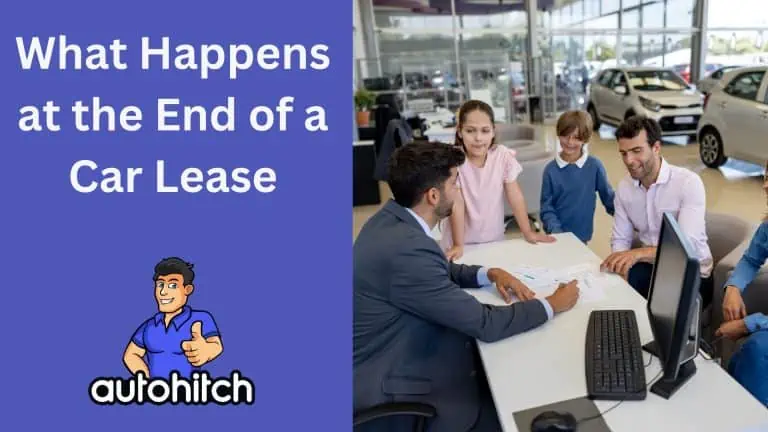If your car lease is ending soon, you likely have questions about what happens at the end of a car lease and exactly what options you’ll have.
With used car prices still high in 2024, deciding whether to return your leased car, buy it, or get a new lease is an important financial decision. This guide examines everything you need to know about the end of car lease process.
Key Takeaways
- At lease end, you can return the car, buy it, trade it in, transfer the lease, or extend your lease.
- Inspect your car thoroughly beforehand and understand your responsibilities for repairs and fees.
- Buying your leased car can save money if its residual value is less than current market value.
- Exceeding mileage limits or having excessive wear can result in fees when returning your leased car.
- Start planning 3-6 months before your lease ends to best understand your options.
Relevant Articles To Read:
Table of Contents
What Are Your End of Car Lease Options?
- Return the leased car
- Buy out your lease
- Trade-in the car into a new lease
- Transfer the lease to someone else
- Extend your current lease
When deciding what to do at the expiration of your car lease, start by considering your budget, how much you drive annually, and your typical length of ownership for vehicles. This helps narrow down the following options:
1. Return the Car
Turning in your leased vehicle as specified in your agreement is always an available choice. You will owe a disposition fee around $300-$500 typically. Return logistics include a lease-end inspection, settling outstanding fees, and paperwork.
2. Buy Out the Lease
Purchasing your leased car often makes financial sense if its residual value buyout price is less than the car’s current market value. This allows you to capture any equity for potential savings on your next car. You can pay the predetermined buyout amount in cash or via a car loan.
3. Trade-in for New Lease
Heading into a new lease lets you drive the latest model every few years. Trading in your current leased car can help offset down payment costs too if it has equity. Shop around for best lease terms first before committing.
4. Transfer the Lease
Also called a lease takeover, this assigns lease payments to another person assuming they qualify and your leaser approves. Limitations exist, so confirm eligibility requirements surrounding insurance, fees, etc, if going this route.
5. Extend Your Lease:
Short lease extensions of 6-12 months may work if you need more time to decide or save up for your next vehicle. Extension fees and mileage impacts vary. Check with your leasing company for availability.
Weighing your end-of-lease options months ahead gives you leverage to negotiate the best rates, shop lenders for pre-approvals, and conduct test drives. Avoid waiting until the last minute if possible.
Preparing for the End of Your Car Lease
- Start planning 3-6 months beforehand
- Thoroughly inspect and clean the car
- Research current market value of your car
- Understand lease contract terms and buyout price
- Obtain a vehicle history report
As your car lease expiration nears, your leasing company will likely contact you with lease renewal or purchase incentives.
While your final decision can wait, making preparations puts you in the best position.
First, meticulously inspect and clean your leased car since excess wear or damage identified at lease turn-in may lead to repair charges. Consider having it professionally detailed if needed.
Next, look up the current market value of your particular leased car using vehicle history sites like Kelley Blue Book (KBB), Edmunds, or Autotrader. We can also help you here at autohitch by looking up what dealers are currently paying for your car.
Compare this real-time value against the residual value buyout price stated in your lease contract.
If the current value exceeds the previously set residual value, buying out your lease could provide savings compared to leasing again. If your car is worth less though, you are best returning your leased car.
Checking your original lease paperwork also lets you review key terms related to mileage limits, fees, and your responsibilities for vehicle condition. This prevents surprises down the road.
Tips for Avoiding Fees at Lease Turn-In
Returning a leased vehicle in poor condition or with too many miles leads to excess wear, overage, and other penalties. Here is how to mitigate extra charges:
- Have minor repairs done like touch-up paint or replacing bald tires
- Detail the car thoroughly inside and out beforehand
- Stick to your annual mileage limits if possible
- Buy added mileage upfront if exceeding your limit to get better rates
- Photograph the car at lease inception and end for easier fee disputes
Following the maintenance schedule is your responsibility too since deferred items like worn brakes must get addressed before lease turn-in as well.
Establishing the condition at lease start versus end makes it easier to appeal unfair fees also. So be sure to take date-stamped pictures when picking up your new car and repeat this at return.
Key Steps at Lease End
The basic process to wrap-up your lease goes as follows no matter what option you select:
- Schedule vehicle inspection
- Understand outstanding payments
- Review terms and conditions
- Decide to purchase, trade-in, return, etc.
- Complete required paperwork
- Pay any final fees
- Sign over ownership documents
First, work with your leasing company or dealership to arrange an inspection appointment within 30 days of lease expiration. This gives time to address issues ahead of facing penalties.
Next, request a current lease payoff quote that lists the remaining monthly payments owed and any other charges if ending early or buying out your lease. Avoid surprises by reconciling this estimated balance with your projected costs.
Carefully read through the original lease documentation as well. Make sure no lingering restrictions exist that might impact your desired plan, like limits on third-party sales.
With all that data collected, pick your best lease end option Confidently and negotiate any lease buyout price if applicable. Ask the dealer to see the inspection sheet, too, so you fully understand potential fees.
Finally, submit necessary paperwork like title transfers or ownership documents before retrieving any security deposit and turning in your car keys. Celebrate crossing the lease finish line!
FAQs: End of Car Lease Questions
Can I negotiate my car’s residual buyout price at lease end?
Yes, you can negotiate the predetermined residual value buyout price stated in your lease when the term expires. Especially if used car values have significantly jumped beyond original estimates, politely ask the leasing manager for a lower number that better reflects current market rates.
What fees should I expect at lease turn-in?
Common end-of-lease charges include disposition or documentation fees of around $400 and any official state tags or taxes tied to a lease buyout scenario. Penalties for excess miles, wear and tear repairs, or extra cleaning may happen, too, if you do not meet your contracted obligations.
What is the best option for leasing again after my car lease ends?
If you wish to lease another new car right after your current term expires, first have your vehicle professionally appraised. Then, negotiate with the dealer on trading in your leased car to reduce out-of-pocket costs if it holds decent equity value and lessen your next down payment.
Can I sell my leased car to Carvana, Carmax or another dealer?
Each leasing company sets its own rules regarding selling or transferring your leased vehicle to a non-affiliated party. Restrictions became more common during the pandemic inventory crunch to maximize returns on in-demand off-lease cars.
Check your contract language or call your leasing company to understand any third-party sale limitations before pursuing this avenue.
Deciding Which Lease End Option is Best
Choosing what to do when your car lease terminates depends on several personal factors – budget, length of ownership preference, buyout versus market value differential, etc.
Carefully weighing these conditions against your available end-of-lease alternatives steers you toward making the soundest financial decision.
Selling a leased car can yield profits if done right while leasing again works best for serial car upgraders.
Above all, avoid last-minute scrambling by reading your contract, assessing value vs buyout pricing, and negotiating where possible. This powers informed choices leading up to your lease expiry deadline.


